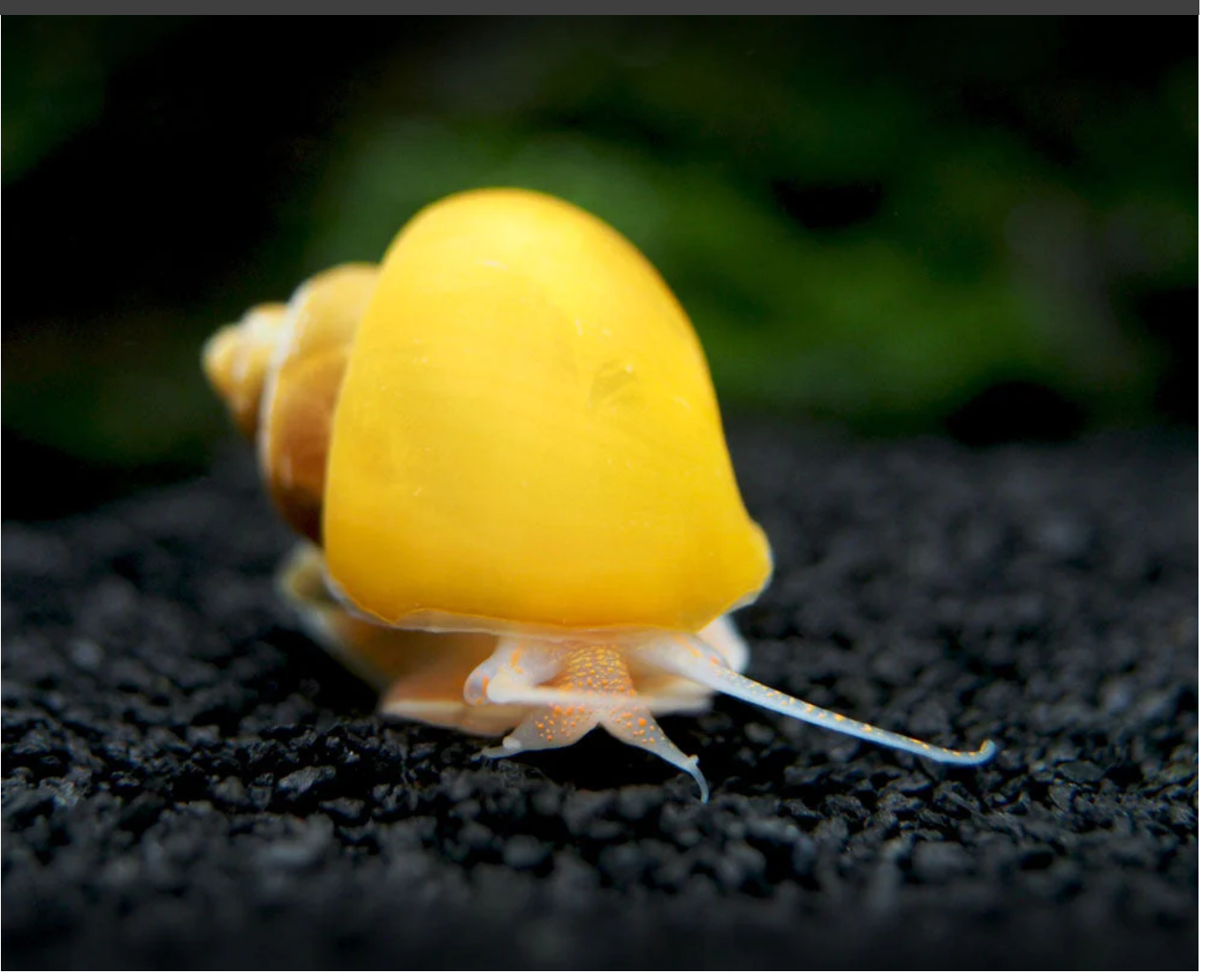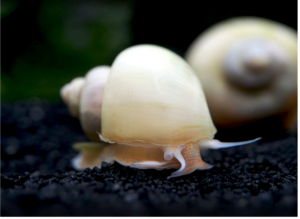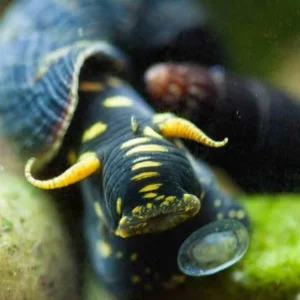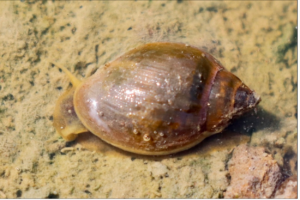When choosing tank snails, appearance and utility are crucial factors to consider. Among the various species of tank snails, the Gold Inca snail stands out with its distinctive coloration and allure, making it a popular choice for aquarium enthusiasts.
Gold Inca snails are freshwater herbivores that consume algae and organic detritus in tanks. They reach an average size of 2 inches (5 cm) in diameter and 3 inches (8 cm) in length, with a lifespan of 1-3 years, depending on care quality. These snails thrive in a minimum 10-gallon (38-liter) tank.
This comprehensive guide aims to enhance Your Gold Inca snail care skills. It covers various aspects such as the snail’s origins and habitat, recommended tank setup, feeding requirements, breeding habits, compatible tank mates, and common issues.
Origin and Habitat
The Gold Inca snail (Pomacea bridgesii) is a freshwater gastropod native to South America, particularly Brazil, Paraguay, and Bolivia. Also known as the Gold mystery snail, it belongs to the Ampullariidae family, which encompasses 120 species.
In its natural habitat, this snail thrives in the following:
- Swamps.
- Rivers.
- Ponds characterized by slow-moving water.
- Dense vegetation.
The Gold Inca snail prefers low-light conditions and exhibits greater activity during the nighttime. During the day, Gold Inca snails seek shelter among submerged vegetation, patiently awaiting the opportunity to scavenge on decaying organic matter.
However, in tanks with limited food supply, these snails will remain active day and night, diligently scouring the tank for any traces of decomposing organic material.
Appearance and Size
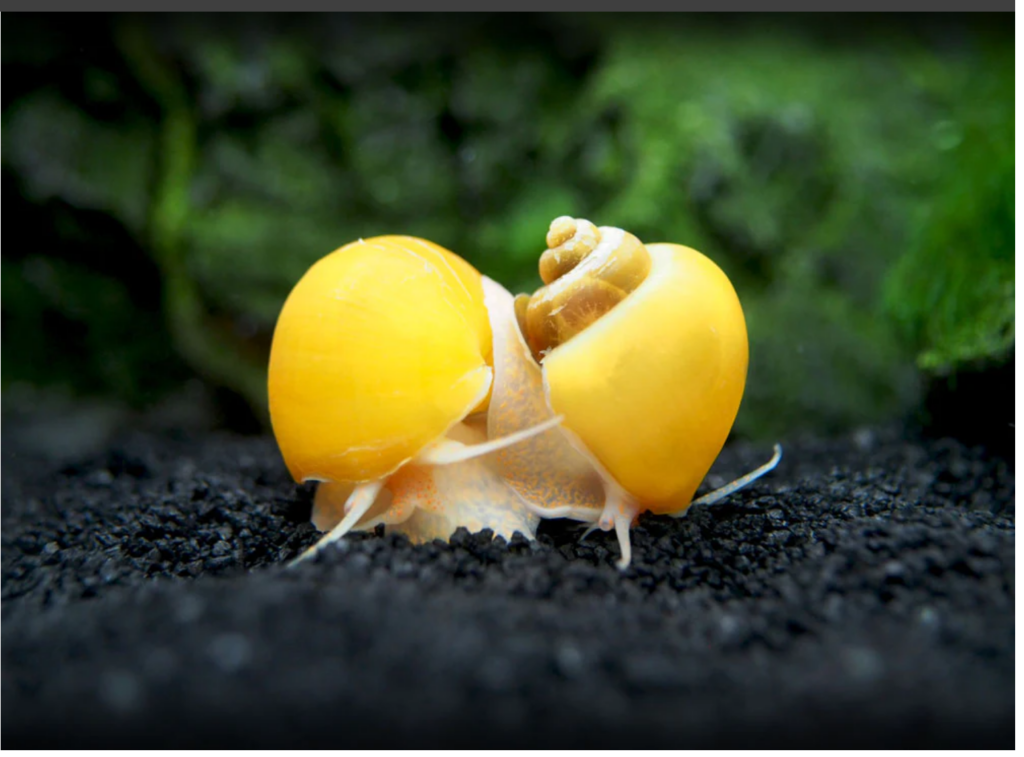
One distinguishing feature of the Ampullariidae family is a siphon extending from the snail’s head. This tube serves as a breathing apparatus when the snail is submerged, alongside its gills.
Interestingly, the siphon of Gold Inca snails is often larger than their own bodies. These snails occasionally extend the siphon above the water surface to breathe, so it’s advisable to leave at least 4 inches (10 cm) of space between the tank water level and the cover to ensure effective respiration.
In terms of color, Gold Inca snails exhibit a deep yellow-to-gold shell with a cream-white body. They sport distinctive orange markings on their head and siphon, particularly around the mouth and eyes. This unique coloration is particularly striking in aquariums with subdued vegetation and a black substrate background.
Like other mystery snails, Gold Inca snails possess an operculum, a rigid plate used to cover the opening of their shell for enhanced protection. A healthy operculum is sturdy and robust.
In regard to size, Gold Inca snails typically reach a diameter of 1-2 inches (2.5-5 cm) and a length of 2-5 inches (5-13 cm). However, the size of a snail is primarily influenced by its diet and water quality.
In the wild, these snails have been observed to grow up to 2.8 inches (7 cm) in diameter and 4 inches (10 cm) in length.
However, under captive conditions with poorer water quality and nutrition, their size rarely exceeds 2 inches (5 cm) in diameter and 3 inches (8 cm) in length.
Gold Inca Snail Lifespan
The average lifespan of a Gold Inca snail is 1 year. However, with proper care and maintenance, these snails can live up to 3 years, while neglected ones often fail to reach their first birthday.
Many aquarists have reported the unfortunate occurrence of their Gold Inca snails dying within the initial year of being introduced to a tank. This snail species is highly sensitive to water quality, and exposure to elevated levels of ammonia or copper can be fatal.
Additionally, the Gold Inca snail is prone to stress caused by harassment from other tank inhabitants.
Related Reading: Can Snails Liive in High Ammonia?
Buying Gold Inca Snails
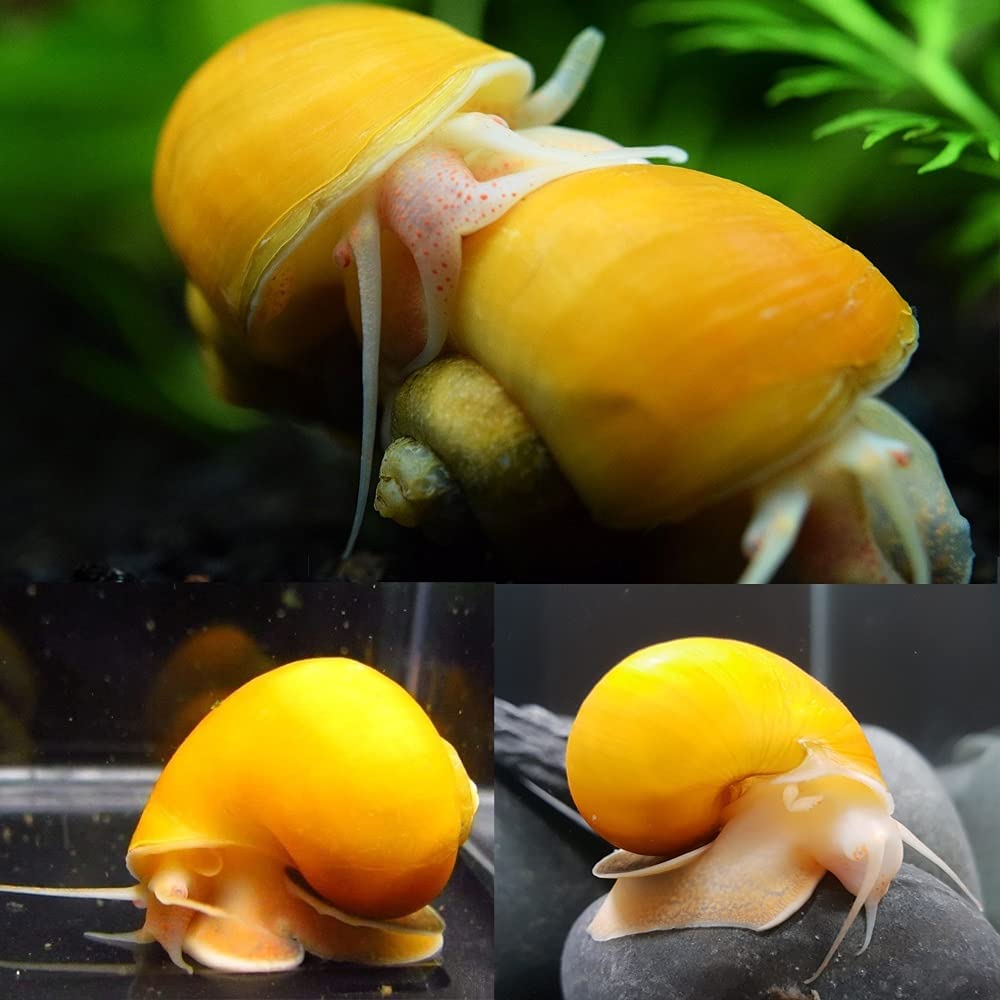
One recommended place to purchase gold Inca/mystery snails is through South Shore Retail on Amazon. They offer a range of sizes, from 1 to 100 snails. With their extensive experience shipping snails, they are well-versed in providing the best conditions for survival. South Shore Retail is also a veteran-owned and operated company, adding to its credibility.
| Preview | Product | |
|---|---|---|

|
SOUTH SHORE RETAIL, LLC Gold Mystery Snails – Wholesale Pricing Available – Dime/Nickel Sized (3) | Check Price |
When purchasing a Gold Inca snail, pay close attention to its activity levels. Opt for a snail that shows the following:
- Actively moving around the tank.
- Grazing.
- Displaying playful behavior.
Avoid snails that appear dormant on the tank floor or float upside down on the water’s surface. Additionally, select Gold Inca snails with healthy-looking shells.
Faded, cracked, or pitted shells are indications of poor snail health. Snails with such shell conditions have likely been exposed to toxic water or are undernourished. Copper, a common tank toxin, can stunt snail growth and lead to these shell issues.
Lastly, consider choosing smaller-sized snails, as they are typically younger. Snail size varies with age, and smaller snails tend to have a longer lifespan. It would be unfortunate to invest in an elderly snail that will only survive for a few months in your tank.
Gold Inca Snail Care
The care requirements for Gold Inca snails are similar to those of other mystery snails. Ensure the following:
- Maintain high water quality.
- Ensure consistent water parameters.
- Provide proper feeding.
- Choose suitable tank mates.
Tank Size
Since Gold Inca snails are peaceful creatures, it is advisable to introduce them to a pre-established tank. Ideally, a minimum tank size of 10 gallons (28 liters) is recommended, as anything smaller would be too cramped for the snails to coexist with other tank mates.
Larger tanks provide a more stable and resilient tank ecosystem, better equipped to handle fluctuations in water parameters.
For hobbyists considering Gold Inca snails, I recommend the Aqueon Standard Glass 10-Gallon Rectangular Tank from Amazon. This tank is sturdy, stylish, scratch-resistant, and affordable.
| Preview | Product | |
|---|---|---|

|
Aqueon Standard Glass 10 Gallon Rectangular Tank for Aquariums & Terrariums | Check Price |
For aquarium enthusiasts interested in maintaining larger populations of Gold Inca snails, the SeaClear 30-Gallon Show Acrylic Aquarium Combo Set from Amazon is a suitable choice. This 30-gallon tank can accommodate larger Inca Gold populations of up to 50 snails.
Acrylic tanks are known for their superior clarity compared to glass tanks. Additionally, this tank includes a built-in lighting system, eliminating the need to source lighting separately.
Regardless of the chosen tank, it is essential to have a lid in place. Gold Inca snails are adventurous explorers and may attempt to escape their enclosure, leading to injury or even death.
Related Reading: Can Snails Feel Pain?
Water Parameters
The Gold Inca snail is known to be quite sensitive and requires consistent water parameters for optimal well-being. These snails prefer tanks with good aeration and minimal water movement.
The following table outlines the ideal water parameters for Gold Inca snails:
| Parameter | Range |
| Temperature | 68 to 82°F (20-28°C) |
| pH | 7.2-7.5 |
| Water hardness | 12-18 kH |
| Light level | Moderate to dimly lit |
| Substrate | Hard sand and gravel |
Maintaining water parameters within these ranges is crucial for the thriving of Gold Inca snail populations. Regular monitoring of these parameters is necessary to ensure their well-being.
I highly recommend the SJ WAVE 7 in 1 Aquarium Test Kit for Freshwater Aquarium from Amazon. This kit can test various parameters essential for maintaining a healthy tank environment. This kit tests pH, chlorine, general hardness, carbonate hardness, nitrate, nitrite, and temperature.
| Preview | Product | |
|---|---|---|

|
SJ WAVE 7 in 1 Aquarium Test Kit for Freshwater Aquarium | Fast & Accurate Water Quality Testing… | Check Price |
As mentioned earlier, copper is a toxic substance in tanks, and it is crucial to maintain its levels at zero to ensure the well-being of snail populations. The Seachem Cuprisorb 100 ml copper and heavy metal removal kit is a necessary addition to your aquarium supplies. This adsorbent is designed to eliminate traces of copper and other heavy metals from your tank.
| Preview | Product | |
|---|---|---|

|
Seachem Cuprisorb 100ml | Check Price |
Vegetation and Substratum









Gold Inca snails thrive in planted tanks as they provide an abundant source of food. These snails are primarily herbivores, relying on plant organic matter and algae.
However, it’s important to ensure the vegetation is not too dense, as it can hinder the snails’ movement.
While Gold Inca snails may occasionally nibble on plant leaves, they are not heavy plant eaters. They typically resort to this when other food sources are scarce.
Ideal plant choices for a Gold Inca tank include (links to Amazon):
- Hornwort (Ceratophyllum demersum)
- Red Root Floater (Phyllanthus fluitans)
- Amazon Sword (Echinodorus sp.)
- Java Moss (Vesicularia dubyana)
- Duckweed (Lemnoideae)
Gold Inca snails also enjoy burrowing and burying themselves in the sand during the day. It is recommended to use fine to medium-grained sand as the substrate, as rough substrates like gravel can cause injury to the snails.
Additionally, adding decorations to the tank can provide additional surfaces for the snails to explore, but make sure not to overcrowd the tank.
Be cautious of decorations made from potentially toxic materials. It is generally advisable to prioritize live plants over decorations in the tank.
Feeding
The Gold Inca snail is an enthusiastic scavenger that diligently cleans hard surfaces in the tank, consuming algae and foraging for edible waste on the tank floor. It is an excellent algae eater that effectively eliminates algae from your tank.
These snails also enjoy consuming soft algae and other organic materials in the tank. However, in community tank setups with high food competition, it is advisable to supplement their diet with the following to ensure their nutritional needs are met:
- Algae wafers
- Blanched vegetables
- Bottom feeder pellets
- Calcium supplements
Calcium is particularly important for proper shell growth. When feeding Gold Inca snails, it is essential to provide them with just the right amount of food.
Remove any uneaten vegetables from the tank after a day to prevent spikes in ammonia levels, which could harm your snail populations.
Breeding
The Gold Inca snail reproduces sexually through cross-fertilization, requiring both male and female snails in the tank for successful fertilization.
Distinguishing between male and female Gold Inca snails can be challenging, so it is recommended to have a group of around 5 snails to increase the likelihood of having both genders.
Once the tank conditions are optimal and the snails are well-fed, you will eventually observe the male mounting the female to deposit sperm in her gonophore. This process can be slow and may last for several hours.
Approximately two weeks after mating, the female will lay eggs and deposit them above the waterline. Females of this species typically prefer laying eggs at night and can release anywhere from 10 to 100 eggs.
Within three weeks, tiny Gold Inca snails will start to emerge from the eggs, already possessing a formed shell. These snails grow rapidly, necessitating an increased food supply within the tank.
It is advisable to transfer the females to a separate tank after mating to protect the eggs from being consumed by other tank inhabitants, including other snail species. In a community tank, the entire egg cocoon can be devoured within days.
Suitable Tank Mates
The Gold Inca snail is a peaceful and non-aggressive species that tends to keep to itself and rarely interacts with other tank inhabitants. When faced with a threat, these snails retreat into their shells and close their operculum until the danger subsides. They can coexist peacefully with non-aggressive fish and invertebrates.
Some suitable tank mates for Gold Inca snails are shown in the table below:
| Category | Tank Mates |
| Fish | Cory Catfish White Cloud Mountain Minnow Pictus Catfish Diamond Tetra PlecoOtocinclus Catfish |
| Snails | Nerite Snails Red Ramshorn Snails Ivory Snails |
| Small-Sized Shrimp | Bamboo Shrimp Amano Shrimp Ghost Shrimp Red Cherry Shrimp |
While these tank mates are generally compatible with Gold Inca snails, individual behavior and compatibility can vary. It’s always recommended to observe the interactions between tank mates and make adjustments as necessary to ensure a harmonious environment.
Gold Inca Snail Common Problems
One of the main issues encountered with Gold Inca snails is shell damage. This can be attributed to various factors but is often associated with unfavorable water conditions and calcium deficiency.
Gold Inca snails can also be affected by parasites such as rat lungworms and grubworms. Also, leeches and flukes are a significant concern, particularly in community tanks.
It is crucial to promptly isolate any snails that display suspicious symptoms to prevent the spread of diseases to other tank mates.
Closing Remarks
The Gold Inca snail is a fantastic choice for beginners and experienced aquarists. Not only is it visually appealing, but it also serves a practical purpose by effectively eliminating algae from your tank. Additionally, it is relatively easy to care for.
However, be aware that the Gold Inca snail is invasive and can reproduce rapidly. Without proper management, you may find an overwhelming number of snails within a short period.
On the positive side, this population can serve as a food source for other creatures, including birds and frogs.
If you have any questions or suggestions, please drop a comment below.
